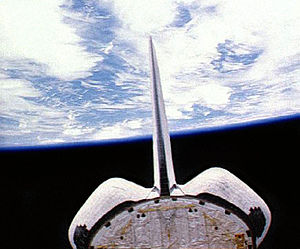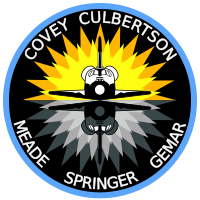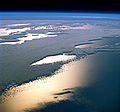STS-38
 Atlantis in orbit; in-flight photography of this Department of Defense support mission is limited | |
| Names | Space Transportation System-38 |
|---|---|
| Mission type | DoD satellite deployment |
| Operator | NASA |
| COSPAR ID | 1990-097A |
| SATCAT no. | 20935 |
| Mission duration | 4 days, 21 hours, 54 minutes, 31 seconds (achieved) |
| Distance travelled | 3,291,199 km (2,045,056 mi) |
| Orbits completed | 79 |
| Spacecraft properties | |
| Spacecraft | Space Shuttle Atlantis |
| Landing mass | 86,677 kg (191,090 lb) |
| Crew | |
| Crew size | 5 |
| Members |
|
| Start of mission | |
| Launch date | November 15, 1990, 23:48:15 UTC |
| Rocket | Space Shuttle Atlantis |
| Launch site | Kennedy Space Center, LC-39A |
| Contractor | Rockwell International |
| End of mission | |
| Landing date | November 20, 1990, 21:42:46 UTC |
| Landing site | Kennedy Space Center, SLF Runway 33 |
| Orbital parameters | |
| Reference system | Geocentric orbit[1] |
| Regime | Low Earth orbit |
| Perigee altitude | 260 km (160 mi) |
| Apogee altitude | 269 km (167 mi) |
| Inclination | 28.45° |
| Period | 89.79 minutes |
 STS-38 mission patch  Standing: Charles D. Gemar, Robert C. Springer, Carl J. Meade Seated: Frank L. Culbertson Jr., Richard O. Covey | |
STS-38 was a Space Shuttle mission by NASA using the Space Shuttle Atlantis. It was the 37th shuttle mission, and carried a classified payload for the U.S. Department of Defense (DoD). It was the seventh flight for Atlantis and the seventh flight dedicated to the Department of Defense. The mission was a 4-day mission that traveled 3,291,199 km (2,045,056 mi) and completed 79 revolutions. Atlantis landed at Kennedy Space Center's Shuttle Landing Facility's runway 33. The launch was originally scheduled for July 1990, but was rescheduled due to a hydrogen leak found on Space Shuttle Columbia during the STS-35 countdown. During a rollback to the Orbiter Processing Facility Atlantis was damaged during a hail storm. The eventual launch date of November 15, 1990, was set due to a payload problem. The launch window was between 18:30 and 22:30 EST. The launch occurred at 18:48:13 EST.
Crew
| Position | Astronaut | |
|---|---|---|
| Commander | Richard O. Covey Third spaceflight | |
| Pilot | Frank L. Culbertson Jr. First spaceflight | |
| Mission Specialist 1 | Carl J. Meade First spaceflight | |
| Mission Specialist 2 | Robert C. Springer Second and last spaceflight | |
| Mission Specialist 3 | Charles D. Gemar First spaceflight | |
Crew seating arrangements
| Seat[2] | Launch | Landing |  Seats 1–4 are on the Flight Deck. Seats 5–7 are on the Middeck. |
|---|---|---|---|
| S1 | Covey | Covey | |
| S2 | Culbertson | Culbertson | |
| S3 | Meade | Gemar | |
| S4 | Springer | Springer | |
| S5 | Gemar | Meade |
Preparations and launch
The launch occurred on November 15, 1990, 18:48:13 EST. It was originally scheduled for July 9, 1990, however, a liquid hydrogen leak found on Columbia during the STS-35 countdown prompted three precautionary tanking tests on Atlantis at the pad on June 29, 1990, on July 13, and on July 25, 1990. Tests confirmed the hydrogen fuel leak on the external tank side of the external tank/orbiter 43.2 cm (17.0 in) quick disconnect umbilical. This could not be repaired at the pad and Atlantis was rolled back to the VAB on August 9, 1990, demated, then transferred to the Orbiter Processing Facility (OPF). During rollback, the vehicle remained parked outside the VAB for about a day while the Columbia/STS-35 stack was transferred to the pad for launch. While outside, Atlantis suffered minor hail damage to its tiles during a thunderstorm. After repairs were made in the OPF, Atlantis was transferred to the VAB for mating on October 2, 1990. During hoisting operations, the platform beam that was to have been removed from the orbiter's aft compartment fell and caused minor damage, which was repaired. The vehicle rolled out to Pad A on October 12, 1990. The fourth mini-tanking test was performed on October 24, 1990, with no excessive hydrogen or oxygen leakage detected. During the Flight Readiness Review (FRR), the launch date was set for November 9, 1990. The launch was reset for November 15 due to payload problems. Liftoff occurred during a classified launch window lying within a launch period extending from 18:30 to 22:30 EST on November 15, 1990.
Classified payload
According to Aviation Week, the shuttle initially entered a 204 km (127 mi) x 519 km (322 mi) orbit at an inclination of 28.45° to the equator. It then executed three orbital maneuvering system (OMS) burns, the last on orbit #4. The first of these circularized the orbit at 519 km (322 mi).
The first classified payload was code-named USA-67,[3] which was deployed from Atlantis' cargo bay on the seventh orbit and ignited its rocket motor at the ascending node of the eighth orbit to place it in a geostationary transfer orbit (GTO). Aviation Week reported that USA-67 was a secret ELINT gathering satellite headed for geosynchronous orbit and launched to monitor the events during the first Gulf War in 1990. As a result of there being two upper stages aboard STS-38, USA-67 was originally believed to be a Magnum satellite like those deployed on STS-51-C and STS-33, which were launched via a two-stage Inertial Upper Stage (IUS).[4] Today it is believed that USA-67 was instead a secret Satellite Data System (SDS-2) military communications satellite, like those deployed on STS-28 and STS-53.[5][6]
It is also believed that USA-67 was not the only satellite deployed during STS-38. A publicly released image of Atlantis' vertical stabilizer and upper aft bulkhead, similar to the one released from STS-53, confirms that the ASE (Airborne Support Equipment) for the Inertial Upper Stage (IUS) was absent from this flight.[7] An explanation is that two separate satellites were deployed, using single-stage Payload Assist Module (PAM-D). Rumors that appear to have been substantiated by the identification of an "unknown" geostationary satellite by amateur observers[8][9] insist that the second payload was a stealth satellite known as Prowler, reportedly intended to covertly inspect other nation's geostationary satellites.[10]
Landing
The mission was extended by one day due to unacceptable crosswinds at the original planned landing site of Edwards Air Force Base. Continued adverse conditions led to a decision to shift the landing to KSC. Landing occurred on November 20, 1990, 16:42:42 EST, Runway 33, at the Kennedy Space Center. The rollout distance was 2,753 m (9,032 ft) and rollout time was 57 seconds. STS-38 marked the first KSC landing for Atlantis, and the first shuttle landing at KSC since April 1985 (the last being STS-51-D). Atlantis weighed 86,677 kg (191,090 lb) at landing.[11]
Gallery
-
 Atlantis (right) and Columbia pass
Atlantis (right) and Columbia pass -
 Sunlight on the ocean
Sunlight on the ocean -
 Launch of STS-38
Launch of STS-38
See also
References
- ^ "Satellite Catalog". Jonathan's Space Page. Archived from the original on October 18, 2018. Retrieved May 24, 2013.
- ^ "STS-38". Spacefacts. Archived from the original on October 30, 2013. Retrieved February 26, 2014.
- ^ "USA-67". NASA. 1990-097B. Archived from the original on August 8, 2020. Retrieved August 21, 2019.
 This article incorporates text from this source, which is in the public domain.
This article incorporates text from this source, which is in the public domain. - ^ Molczan, Ted (January 21, 2011). "Unknown GEO Object 2000-653A / 90007 Identified as Prowler" (PDF). Visual Satellite Observer's Home Page. Archived (PDF) from the original on July 27, 2011. Retrieved February 25, 2011.
- ^ "Satobs.org: USA-67 observations". Archived from the original on September 27, 2007. Retrieved July 28, 2007.
- ^ "FAS.org: GEO SIGINT Satellite". Archived from the original on December 27, 2007. Retrieved December 1, 2007.
- ^ "The Gateway to Astronaut Photography of Earth". Eol.jsc.nasa.gov. Archived from the original on February 25, 2012. Retrieved August 12, 2010.
 This article incorporates text from this source, which is in the public domain.
This article incorporates text from this source, which is in the public domain. - ^ "Ted Molczan, satobs.org: Unknown GEO Object 2000-653A / 90007 Identified as Prowler" (PDF). Archived (PDF) from the original on July 27, 2011. Retrieved July 6, 2011.
- ^ "Ted Molczan, satobs.org: Evaluation of the opportunity to launch Prowler on STS-38" (PDF). Archived (PDF) from the original on July 27, 2011. Retrieved July 6, 2011.
- ^ "Robert Windrem, NBC News: What is America's top-secret spy program?". Archived from the original on September 15, 2023. Retrieved November 17, 2019.
- ^ "Space Shuttle Missions Summary" (PDF). NASA. September 2011. p. 2-41. Archived (PDF) from the original on February 3, 2023. Retrieved January 31, 2022.
 This article incorporates text from this source, which is in the public domain.
This article incorporates text from this source, which is in the public domain.
External links
- NASA mission summary Archived May 27, 2010, at the Wayback Machine
- STS-38 Video Highlights Archived July 15, 2014, at the Wayback Machine
- Astronatix: STS-38
- v
- t
- e

- Retired















